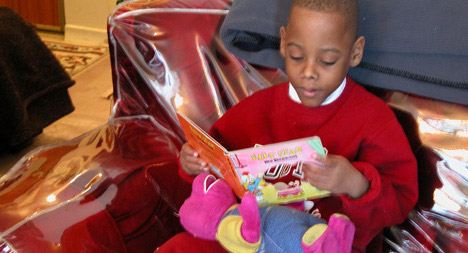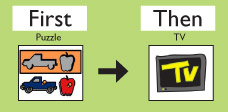
Most young children have a tough time sitting still for very long periods of time. Young minds and bodies need to be kept active. However, some children are easily distracted may have a hard time focusing on one topic or activity. They may be busy watching what others are doing, distracted by their surrounding, or interested in other play materials. Children who are bored or restless sometimes do things to entertain or stimulate themselves. They may hum, play with their clothing, touch, or talk to other people around them. A child who is sensitive to sights, sounds, smells, or textures this can also lead to restlessness, or an increased need to self-stimulate.
For example, Franco needs extra visual stimulation so he twirls a piece of string in front of his eyes. When Franco is focused on watching the string, he does not pay attention to looking at the book.
Keep in mind that some children with these sensitivities may need extra support and understanding to focus and participate in activities for longer periods of time.
As a parent, teacher or early childhood professional you can answer the following questions to help you decide whether your child needs more support to participate successfully in activities. Remember that the amount of time a young child focuses on a favourite activity can vary depending on their age and developmental level.
- Does he watch a favourite television show or short video from start to finish?
- Does he sit and listen quietly to a short story read out loud?
- Does he sit and listen to music?
- Does he answer when someone calls his name?
- How long can he play with a toy he enjoys?
- How long does he stay in the room when favourite friends or family members are visiting?
- Does he stay at the table for the entire meal?
The environment can also affect concentration and focus. Here are some suggestions on setting up the environment to help your child focus better:
- Choose a quite area.
- Reduce background noises by shutting the door, turning off the TV, or music.
- Set up a work area with a child-size chair and small table. Parents could also use a coffee table.
- Make sure your child is comfortable when sitting at the table. Support his feet if they are not touching the floor by using a stool, bench, or telephone book.
- Have your child sit on the floor to do the activity if he is uncomfortable at the table. You can give them a special pillow, mat, or rug to sit on.
- Use a tray or placemat to define his work space.
- Make sure you have all the materials you will need so that you do not have to go searching for them once you start.
- Make sure there is enough light for them to see, but not too much to be distracting.
- Have them dressed in comfortable clothing – ensure they are not too cold or too warm.
Now that we have looked at some environmental factors, here is a list of “child factors” that can affect your child’s ability to focus during activities:
- Feeling hungry, tired, or sick.
- Not interested in the activity.
- Easily distracted by something else in the room.
- Needs to use the washroom.
- Has physical energy he needs to ‘burn off’.
- Energy level seems too low.
If you think that they are more alert and ready to learn in the morning, or perhaps after having a nap, you may want to introduce a new activity during that time period.
Encouraging Participation in Activities:
- Provide your child with a signal that playtime at the table will begin. You can do this by giving him a verbal warning “Playtime”, by using a physical gesture, or by using a visual cue such as a playtime picture.
- Help your child make the transition to the table by allowing him to carry a piece of the activity (e.g., a piece of the puzzle or rolling pin for the playdoh) or the picture of that activity.
- Singing a transition song while physically guiding your child to the table (e.g., “Time to sit at the table” to the tune of “The Farmer in the Dell”).
Encouraging Focus During Activities:
- Show your child what to do or model how to complete the activity. For example, putting in the first piece of the puzzle
- Provide your child with assistance, when needed, to complete the activity. This can be a gentle hand over hand assistance or offering verbal directions.
- Gradually increasing the amount of time your child is expected to sit at the table. To promote success, start with short periods of time. You can use a timer to show them how long they need to stay at the activity. Use a timer to help them understand how long the activity will be.
- Help your child to finish the activity if they lose interest, or before the expected time has passed. Have him complete one more piece of the activity to finish. This keeps the activity positive for your child and teaches him that they need to follow through with the expectation.
- Use toys that have a clear beginning and end, such as an insert puzzle, stacking ring or cup, shape sorter, beading, pegboards or “Mr. Potato Head”. This way your child will get quick, positive feedback for “completing” the activity. “Wow, puzzle finished”!
Here are a few more ideas you can try to help your child focus during activities:
- Provide your child with a balance of active and seated activities throughout the day.
- Give your child a small toy to hold if they become restless to help him remain at the activity. These are also known as “fidget toys”.
- Have visuals of the rules/expectations for your child to let him know what is expected during this time (e.g., stay at the table, listen, finish puzzle).
- You may also choose to use a “First” – “Then” approach. For example tell your child (and show him by using pictures) “First puzzle” (the activity you want him to do), “Then Computer” (an activity he enjoys). This will help your child expand the length of time he spends focusing on an activity.
- Reward your child for focusing on activities by offering him stickers (or something he really likes), hugs and verbal praise.

Remember that the length of time your child takes to develop the ability to focus during activities will vary. It is important to practise often, but most importantly, remember to have fun!
